Rosa Elena Egipciaco was born in Moca, Puerto Rico, a center of the form of lace making known as mundillo. The art form originated in Italy in the sixteenth century and probably was brought to Puerto Rico by Spanish colonists. It was a tradition in Egipciaco’s family, and she began learning it as a child.
“I don't know if I was 4 or 5 years old,” she told NEA interviewer Mary K. Lee. “The only thing I remember is that when I went to first grade I already knew how to make the little pieces. Very narrow, of course, and simple, but I remember that I made them. … My mother said, ‘You were so bright that you learned immediately.’ It was easy for me. Many people like to learn how to make the laces by the yard, but I was impatient. I wanted to make things I could finish quickly, so I could start on another one. I liked to make collars and appliqués for dresses, because I could make them quickly and make lots of them. I combine the different basic stitches and make my own designs. I like to combine, for example, the bracero, a beautiful stitch, with a clara and a margarita. I love margaritas — they are like flower petals — and they look so beautiful when you combine eight or ten together to look like a real flower. The designs that come from Spain generally don't have margaritas. … But my designs almost always have margaritas.”
Egipciaco uses a wooden loom with bobbins that help to manipulate the thread and keep the pattern taut. Hundreds of bobbins are required for some patterns. But she has always found the exacting work exhilarating.
“When I was a child (many decades ago)," Egipciaco wrote in her artistic resume, “I used to make laces in the company of other friends who came to my home and sat with me in front of my house. As they were older, they had boyfriends, and those young men handed them notes and letters that my friends hid in the back of the loom used to make laces. In this way, their parents did not know about their love interests. As I did not go to the beach or to any other country on vacation, making laces was my hobby and that of the young girls and young ladies of some of the other traditional towns in Puerto Rico.”
Egipciaco received a Bachelor of Arts from the University of Rio Piedras, Puerto Rico, and a Master of Arts from New York University. As president of the cultural center in her hometown, she lectured on mundillo at universities and festivals throughout Puerto Rico. She relocated to the United States in 1986 and settled in New York City, where she has taught at Baricua College and in many other venues. Her work has been displayed at a number of universities and museums.
Egipciaco is a demanding teacher. “I always tell my students to buy the graph paper because I want them to make laces in a perfect way,” she told Lee. “I know that only God is perfect. I know that. But I try to be as perfect as possible.”
“It is very sad that this beautiful art is dying,” she wrote in her resume. “This is why I am constantly creating designs of collars, bonnets, purses, tablecloths, doilies, baby booties, napkins, pillowcases, picture frames, etc. … Mundillo have always been associated with luxury, kings and queens, elegance and grace. Even Queen Isabella of Spain elaborated them with gold and silver thread as gifts for the church. I would love to have money to build a museum in my hometown and donate all my designs and laces to that piece of land I love so much. Perhaps other lace makers can follow my example.”




















